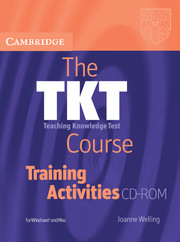2.5 - Resource library
Published online by Cambridge University Press: 09 February 2024
Summary
Instructions
1. Display board diagram (on overhead or multimedia projector, or write on board) to introduce topic of teaching resources and materials. Allow three minutes for trainees to discuss in pairs how each item differs from the others. Conduct feedback, establishing the main differences between the four categories.
2. Have trainees form a circle around the resources table. Have them sort the resources into four initial piles: reference resources, coursebook package elements, supplementary materials and teaching aids. Allow just one minute for this as changes can be made at the next stage.
3. Divide the class into four smaller groups and allocate one pile to each. Explain that each group should review the contents of their category and sort them into three different subgroups:
1) items which definitely belong only in their category (e.g. dictionaries in reference resources)
2) items which don't belong in their category
3) items which could also go into a different category
4. Conduct feedback, asking each group to present their subgroups. Hand out the worksheet and have trainees complete the first table, writing a definition and example of the four different resources.
5. Ask trainees to put aside all items which they have categorised as solely aids, supplementary resources or coursebook elements, so that only the reference resources are left on the resource table.
6. Display the reasons for using reference resources (either on an OHT, the board or on cards). Ask trainees which reasons seem most familiar to them.
7. Finally, have trainees sort the reference resource pile into subcategories using the reasons. To close the activity, refer students to the second table on the worksheet, and have them record their findings there.
- Type
- Chapter
- Information
- The TKT Course Training Activities , pp. 59 - 61Publisher: Cambridge University PressFirst published in: 2024

